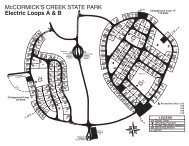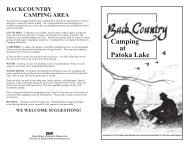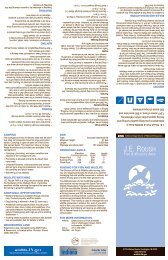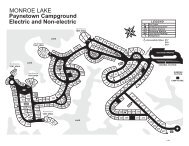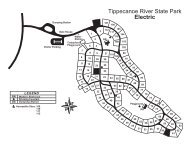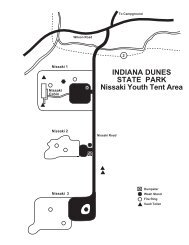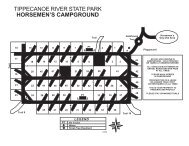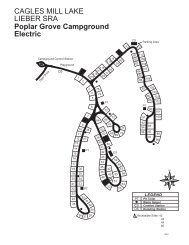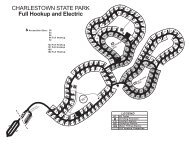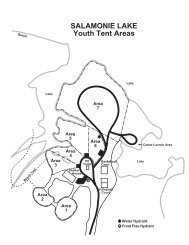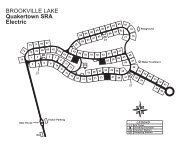Park Map/Brochure - Indiana Outfitters
Park Map/Brochure - Indiana Outfitters
Park Map/Brochure - Indiana Outfitters
- No tags were found...
Create successful ePaper yourself
Turn your PDF publications into a flip-book with our unique Google optimized e-Paper software.
Description of Hiking TrailsHarrison Trace Trail: EASY — 2.5 mile loop viaDuck Pond.This is an asphalt surface trail intended forwalkers, bicyclists, and joggers. The trail begins at theDelaware Lake Picnic Area. After passing DelawareLake, the trail follows the rolling upland above FallCreek. Although the trail is graded and paved, it is notflat. Much of the trail is tree covered and wildflowersgrow next to the walking surface all season long. Thisis the easiest route to Duck Pond.Fall Creek Trail: MODERATE — 1.1 miles to DuckPond. Start this trail at the northeast corner of the DelawareLake Picnic Area. The trail follows the lowlandsalong Fall Creek and then heads uphill as it nears DuckPond. Overall distance can be shortened or varied bytaking one of the three cut-off trails that connect to theHarrison Trace Trail. Excellent for birding, fishing access,wildflower and tree identification.Camp Creek Trail: MODERATE — 1.0 mile toDuck Pond. Pick up this trail at the northeast side ofDelaware Lake as it branches from the Harrison TraceTrail. The trail follows a woodland ravine, then climbsto the upland forest. This is the choice for the earliestspring flowers, and a wide variety of trees.Lawrence Creek Trail: MODERATE — 2 mile loop.Begin this trail at either the Lawrence Creek Trailheador the WalnutTrailhead parking area on the west sideof the park. The trail winds through upland woods andravines. An excellent choice for fall color. Northernsections of the trail tend to remain wet all summer,providing a wonderful wildflower show.Camp Glenn Trail: MODERATE — 1 mile. Begin atthe Lawrence Creek Trailhead. The trail crosses thecreek and quickly climbs the ridge with great views tothe north and west. Once in the woods the trail headssouth to the Nature History Center, Saddle Barn andold CMTC camp in the Camp Glenn Hational HistoricDistrict. You may also begin this trail at the Bird ViewingArea north of the Nature History Center.Tree ID Trail: EASY — 1 mile. This mowed trail followsthe outer edge of the picnic area in Camp Glenn.Look for the wooden posts with metal signs to helpyou ID each type of tree along the route.Schoen Creek Trail: EASY — 0.5 mile. Begin at theparking area east of the picnic area road at CampGlenn. Follow the mowed trail through wetland andprairie grasses; watch for grassland birds and listenfor frogs in spring and summer.THIS IS YOUR PARKAll visitors are expected to observe the following ruleswhich are designed to fulfill the purpose for whichstate parks were established, namely, to preserve aprimitive landscape in its natural condition for the useand enjoyment of the people.RULES AND REGULATIONS• Do not injure or damage any structure, rock, tree,flower, bird or wild animal within the <strong>Park</strong> . Do NOTgather limbs, brush or trees (either dead or alive) forfirewood! It MUST be allowed to remain to rebuildthe natural humus.• Any firearm (except validly licensed handguns) BBgun, air gun, CO2 gun, bow and arrow, or speargun in possession in a state park must be unloadedor un-nocked and stored in a case or locked withina vehicle except when participating in an activityauthorized by written permit..• Dogs and cats must be kept on a leash no longerthan six feet and attended at all times.• There shall be no vending or advertising without permissionof the Department of Natural Resources.• Overnight camping is not allowed in the park.• Fires shall be built only in places provided.• You are in a day use park. Help us keep it clean.Please comply with the Carry In/Carry Out trashpolicy and take all your trash with you when youleave the park.• Motorists must observe speed limits as posted. <strong>Park</strong>in designated areas only. Roadside parking is notallowed. Motorized vehicles are not permitted onhiking trails, the Harrison Trace trail, or through thebicycle/pedestrian entrance on Boy Scout Road.Snowmobiles are prohibited.• Drinking water should be taken only from pumps,hydrants or fountains provided for that purpose. Thiswater is tested regularly for purity.• Report lost or found articles to the park office.• Pull off roads while observing wildlife. Feeding ofwildlife is prohibited.• Use of metal detectors is prohibited.• No mountain biking is allowed in the park.For a complete list of rules and regulations inquire at park office.INDIANAFortHarrisonSTATE PARKLandscape and history blend in a uniquesetting in northeast <strong>Indiana</strong>polis at FortHarrison State <strong>Park</strong>. Located at PostRoad and 59 th Street, the 1700-acre parkfeatures walking and jogging trails, picnicsites, fishing access to Fall Creek and twonational historic districts.Visit the Nature History Center to viewexhibits and experience the preservedCitizen’s Military Training Camp, CCCHeadquarters, and World War II prisonerof war camp. Springtime is a great seasonto enjoy woodland wildflowers, watch forwarblers migrating north or listen for theelusive Pileated woodpecker. The sleddinghill and fitness walking are greatwinter activities.ACTIVITIES AND FACILITIESBiking — Allowed only on paved park roads andthe Harrison Trace Trail. Bicycles are not allowed ongravel or dirt hiking tails or the golf course.Fishing — A state license is required and is availableat the park office or local stores. Check parksigns and bulleting boards for special regulations.Horse Trail Rides — Guided rentals are availableduring the operating season from April throughOctober. For more information regarding operatinghours, lessons, hayrides and special event rides call317-541-1866 during the season.NATURe HISTORY CENTER — Experience thenatural and cultural history of the park through parkand interpretive programs. Open all year. For moreinformation call 317-591-0122. Visit <strong>Indiana</strong> State<strong>Park</strong>s and Reservoirs Interpretive Services at www.interpretiveservices.IN.gov.Natural Resources Education Center— This state wide DNR facility specializes in curriculum-basedteacher training programs such asProject WILD, Project WET, PLT and volunteer basedHoosier Riverwatch and Adopt-A-River programs.For more information visit www.dnr.IN.gov/nrec orcall 317-562-1338.Picnic Areas — Tables, grills, toilet facilities,play-ground equipment and playfields are providedthroughout the park. Large picnic shelters may bereserved through the Central Reservation System.There is no camping at the park.RECREATION BUILDINGS — Two recreation buildings701 and 702 located in Camp Glenn are availablefor rent. Call 317-591-0904 for more information andrental fees.Winter Activities — With proper snow conditions,the sledding hill is open until dusk and crosscountryskiing is allowed on park trails. Peacefulwoodland walks and winter birding await the warmlydressed adventurer! Reddick Shelter equippedw/firelplace.<strong>Park</strong> Hours:Regular Season: April - October — 7:00 am - Dusk*Off Season: November - March — 8:00 am - Dusk**For dusk closing hours check the posting at the frontgate or call 317-591-0904. Gates close promptly.CENTRAL RESERVATION SYSTEMSReservations for all types of camping, family cabins,and shelters at state parks, reservoirs and forests canby made by going online or use the toll free number.1-866-6campIN(1-866-622-6746)www.camp.IN.govTHEGARRISONR E S T A U R A N T. . . at the gateway to Fort Harrison State <strong>Park</strong>CAMP.CENTRAL RESERVATION SYSTEM• full-service dining• banquet seating for 300• 2 breakout rooms• Harrison House - 7 Suites• Officer's Homes - 3, 2 story, 3 bedrooms- sleeps 10Information toll free: 1-877-937-3678Reservations: 1-877-lodges1(1-877-563-4371)Online: www.indianainns.com- 18 hole golf course- driving rangeFor Reservation & InformationCall: 317-543-9597FOR MORE PARK INFORMATIONSTATE PARKSRESERVOIRSWrite: Fort Harrison State <strong>Park</strong>5753 Glenn Road<strong>Indiana</strong>polis, IN 46216Call: 317-591-0904DNR<strong>Indiana</strong> Department of Natural Resourceswww.dnr.IN.govSPECIAL NOTEReceipts from admission and service charges are used to helpdefray the operation and maintenance costs of the park. List offees available in the park office.The programs, services. facilities, and activities of the <strong>Indiana</strong>Department of Natural Resources are available to everyone.DNR prohibits discrimination on the basis of race, color, nationalorigin, age, sex, or disability. If you believe that you have been discriminatedagainst in any program, activity, or facility as describedabove, or if you desire further information please write to: Departmentof Natural Resources, Executive Office, 402 W. WashingtonSt., Rm. W256, <strong>Indiana</strong>polis, IN 46204, 317-232-4020.3/21/07Glacial advances into Central <strong>Indiana</strong> left fertileground colonized by lichens, mosses, and wildflowers.Over time a rich soil supported a hardwood forest composedof beech, maple, sycamore, and ash. Wildlifeincluding elk, bison, river otter, black bear, passengerpigeon and bass filled the drainages of the Fall CreekValley.Native American peoples found their way into thisregion at least 8000 years ago and developed lifewaysthat we celebrate today. Euro-American settlersmoved from Kentucky and Ohio, establishing the firsthomesteads in the 1820’s. They cleared the woodlandsto make way for an agricultural economy.The creation of the military post came about due tothe changing face of the state and nation. During theCivil War, the <strong>Indiana</strong>polis Arsenal supplied munitionsto federal troops. Located near the State House from1861 to1865, the War Department later moved thearsenal east of downtown to Woodruff Place. By1901 as the city grew even larger, the War Departmentplanned to close the arsenal entirely.Many community members felt strongly that somemilitary presence should remain in the city to honorthe tradition the arsenal played in ending slavery andmaintaining the Union. Lt. Colonel Russell Harrison,son of deceased President Benjamin Harrison, suggestednaming any remaining military facility in honorof his father.On June 28, 1904 the War Department issued GeneralOrder No. 117 officially announcing the purchaseof land for “military purposes ... about nine milesnortheasterly from <strong>Indiana</strong>polis.” In 1906, PresidentTheodore Roosevelt dedicated Fort Benjamin Harrisonin honor of the 23rd President and <strong>Indiana</strong>polisresident.On a national scale, the fort represented the firsteffort to create a “national “ army out of a collectionof state militias. The post served multiple roles astroop reception center, classroom, and soldier supportfacility during all major military conflicts from WWIto Desert Storm. Today, Fort Harrison State <strong>Park</strong>continues to preserve the greenspace that the Armykept out of development from 1903 - 1996. Today,you can experience forests and meadows, wildlife,and revealing glimpses into our past.PLEASE STAY ON MARKED TRAILS!Please carry out all trash you produce in orderto keep your park clean and beautiful for othersto enjoy!




